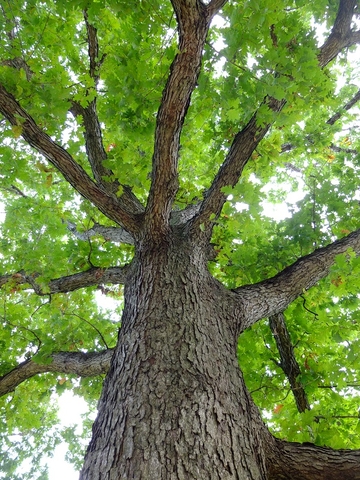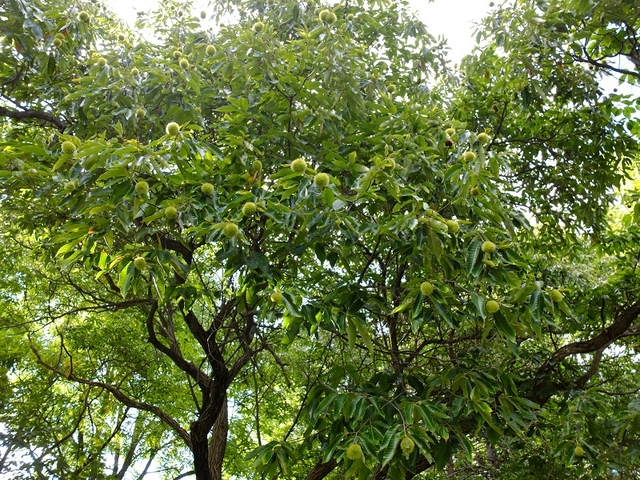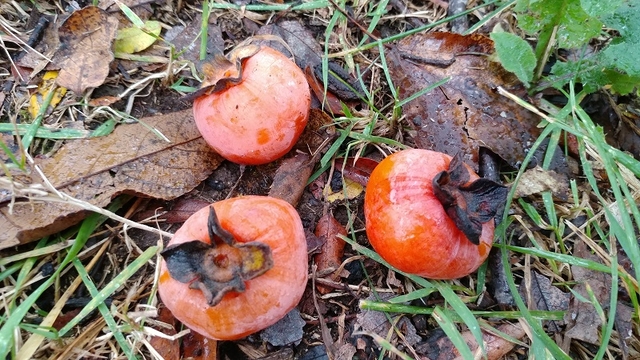The tree crop supply chain may be envisioned as a tree with five branches representing Producer, Gatherer, Processor, Distributor, and Consumer. Each branch can exist independently, but with a connective structure to unite them in an economically-viable system, the potential for a real bioregional tree crops industry increases enormously. Let’s look at some of the main challenges for each branch.
 Figure 1. Bur Oak
Figure 1. Bur Oak
Producer – The long wait when working with trees that live as long as several human lifespans make it difficult for property owners to realize return on their investment. Nut trees may not begin bearing until 10-30 years old, and they may not hit their peak until they are 100-200 years old, making them an uneasy fit to a conventional orchard property ownership. If we turn the value of non-timber forest products like tree crops into real revenue, the economic value of a living tree for its fruits may in time surpass its value as timber and incentivize long-term preservation.
 Figure 2. Chestnut Burs
Figure 2. Chestnut Burs
Gatherer - Finding and properly paying for the skilled labor to gather, sort, and grade nuts and other produce is a huge challenge. Tree crops drop over a period of weeks or months, presenting with indeterminate ripening. Ideally, nut gathering per tree ought to be a daily activity in season. Any nuts left on the ground longer than a day often fall prey to weevils, squirrels, or other critters. Having an adequately paid and educated gathering crew is essential to success every autumn.
Processor - Working with tree crops can be straightforward or complicated, depending on the nut, and can include several steps such as husking, cracking, separating, expelling, milling, pulping, and more. Processing may require engineering, or old-fashioned elbow grease. Suitable machinery may already exist, but might be cost-prohibitive for a small operation. This is where a processing hub capable of receiving tree crops and sending out value-added products becomes essential.
 Figure 3. Grainger Shagbark
Figure 3. Grainger Shagbark
Distributor and Consumer - Fortunately, as far as sales and marketing goes, tree crop products speak for themselves, and building consumer-level market share is mostly about patience, relationships, and respect.
 Figure 4. Persimmons
Figure 4. Persimmons
To unite these branches together, we have settled on a cooperative business model and are building the Keystone Tree Crops Cooperative. The cooperative model equips us with the right framework we need for both economic and cultural success. Trees are keystone species of eastern North America, just as a tree crop cooperative functions like a keystone for bioregional livelihood. And, we’re headquartered in Pennsylvania, the Keystone state.
In acknowledgement of interdependence, the business model allows profits from one class to be democratically reinvested in mutually agreed upon proportions into other classes in the value chain, ensuring that all branches achieve right economic livelihood, and are mutually supportive. We designed the model to be scalable and replicable, and invite you to join us and we hope it inspires others.
We are pleased to be partnering with SilvoCulture, a non-profit based out of Frederick, Maryland. SilvoCulture is focusing primarily on the Producer, Gatherer, and Processor branches, and its mission is “Investing in tomorrow’s ecologies and economies by planting food forests today.” In addition to being involved in tree crop plantings, this fall they will be harvesting and processing chestnuts from established orchards and working with bitternut hickory and black walnut gatherers to process nut oils.
Together, we hold our values front and center. We value bioregionalism, aiming to create anti-fragile regenerative landscapes independent of geopolitical disturbances. For us, this means an economy centered around tree crops as these are resilient, long-lived, low-input, carbon-sequestering organisms yielding nutrient-dense food. Any society built around them will share these virtues. We value individual empowerment, equitability, and education. We value right livelihood in economics as well as in ecological relationship. Each of the values we recognize here as pillars upholding social, cultural, and environmental justice.
The abundance and generosity of trees cannot be overstated, but for us we are limited by the labor we can do. It is the steady, symbiotic nature of the work which itself begins to reveal a path towards the multigenerational culture of stewardship that we so greatly need in these times. May the next generation sit beneath the shade of the trees we tend today.


